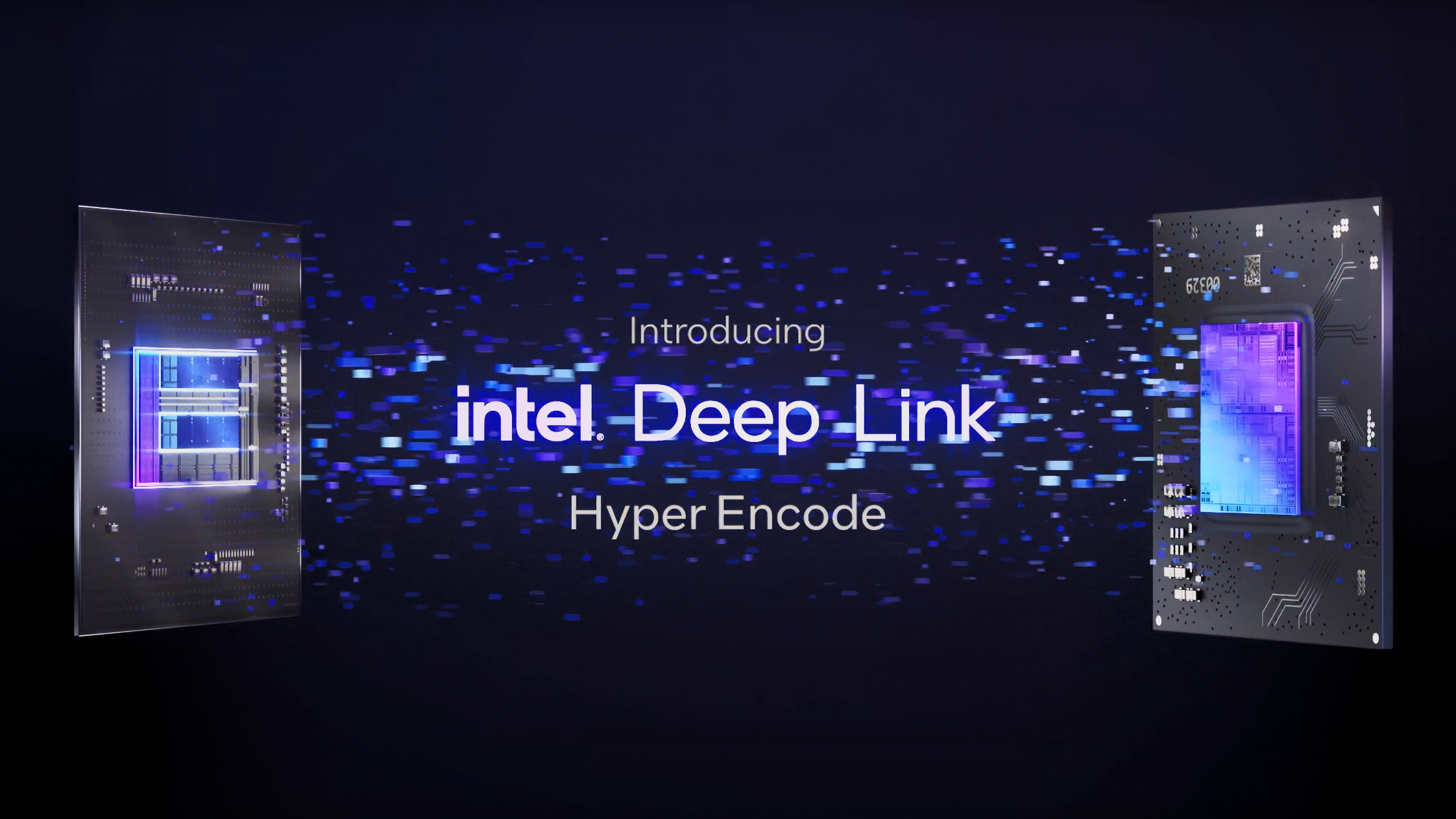Intel stealthily pulls the plug on Deep Link less than 5 years after launch
You can continue to use the technology, but it will not receive any future updates or support from Intel.

Intel has discontinued support for its Deep Link suite of technologies, as confirmed by a representative on GitHub, via X user Haze. After Intel quietly stopped promoting the feature in newer products such as Battlemage, it has now confirmed that active development for Deep Link has ceased. While you still might be able to use Deep Link, Intel has clarified that there will be no future updates or official support from their customer service channels.
Deep Link was introduced in late 2020. It allows you to harness the combined power of your Intel CPU and Arc GPU to improve streaming, AI acceleration, and overall efficiency. To utilize Deep Link, you needed an Intel 11th, 12th, or 13th Generation CPU and a dedicated Arc Alchemist GPU. The suite offered four key utilities: Dynamic Power Share, Stream Assist, Hyper Encode, and Hyper Compute.
Dynamic Power Share optimizes performance and power by intelligently shifting power resources between the CPU and GPU. Stream Assist improved streaming by offloading the task from the dedicated GPU to the integrated GPU. Hyper Encode accelerated video encoding using multiple Intel processors. Lastly, Hyper Compute leveraged your Intel CPU and GPU to accelerate AI workloads in OpenVINO.
"Deep Link is no longer actively maintained and will not be receiving future updates, meaning that there will be no changes to the features regardless of their current functionality status."
Intel representative at GitHub
These features boosted performance in apps like OBS, DaVinci Resolve, and Handbrake. The user who originated the thread at GitHub could not get Stream Assist up and running with OBS using the latest Arc B580 paired with the Core Ultra 7 265K. Following a month-long wait, a representative relayed that Intel had discontinued software development.
It turns out that even Alchemist users had a hard time getting these features working in Handbrake and OBS. It's possible that Intel considered Deep Link a niche feature and deemed the ongoing effort and investment not worthwhile. Besides, most of these features require per-vendor validation. Development was likely dropped a while back, as Meteor Lake, an architecture that dates back to late 2023, is also not among the supported CPUs.
Follow Tom's Hardware on Google News to get our up-to-date news, analysis, and reviews in your feeds. Make sure to click the Follow button.
Stay On the Cutting Edge: Get the Tom's Hardware Newsletter
Get Tom's Hardware's best news and in-depth reviews, straight to your inbox.

Hassam Nasir is a die-hard hardware enthusiast with years of experience as a tech editor and writer, focusing on detailed CPU comparisons and general hardware news. When he’s not working, you’ll find him bending tubes for his ever-evolving custom water-loop gaming rig or benchmarking the latest CPUs and GPUs just for fun.
-
AngelusF ReplyIt's possible that Intel considered Deep Link a niche feature
Intel graphics cards are a niche feature themselves. -
hotaru251 Reply
i mean intels top beats the 5060 ti by 10(ish) fpsAngelusF said:Intel graphics cards are a niche feature themselves.
the 60 tier gpu are the most popular of gamer gpu's.
So long as they keep improving they should easily outdo low end of nvidia/amd -
HardwiredWireless Reply
Alson't? That's some serious lazy right there. The slacker is strong in this one.Admin said:Intel has ceased developing its Deep Link technology, which combined your Intel CPU and Arc GPU for improved encoding, streaming, and efficiency.
Intel stealthily pulls the plug on Deep Link less than 5 years after launch : Read more -
jlake3 Reply
I hear that availability is improving elsewhere, but in the US they remain niche because 5 months after release B580 availability remains terrible. Microcenter is perpetually OoS, and my local store's last shipment was all of 3 cards. Amazon has cards, but they start from $389+tax. Newegg has cards, but the cheapest one is $310+tax, which is apparently on sale from it's usual price of $360... but it doesn't show up if you go into the GPU section and use the filters in the sidebar, only if you do a search for "Intel B580".hotaru251 said:i mean intels top beats the 5060 ti by 10(ish) fps
the 60 tier gpu are the most popular of gamer gpu's.
So long as they keep improving they should easily outdo low end of nvidia/amd
Even if the perfomance is in the mainstream, availability and sales numbers appear to remain niche (in the US, at least). -
006_Bill Reply
:LOL:HardwiredWireless said:Alson't? That's some serious lazy right there. The slacker is strong in this one. -
rluker5 AMD has already learned their lesson with stuff like this so they aren't even trying anymore. Remember that crossfire subset with APUs and very weak, matching laptop dGPUs? Even Crossfire in general. This was pretty much just crossfire for laptop video encoding so not a big loss.Reply
But how long will it take for Intel and AMD NPUs to lose support and stop taking a bunch of die space for the same reason - lack of adoption and interest?
Even Windows can't keep up the software support needed to stay relevant on their own without dev support. Look at what happened with Windows phones.
A pragmatic move by Intel. -
TerryLaze Reply
Wasn't that a directx 12 feature (maybe vulkan as well, I don't remember) that MS, and the game devs, just didn't chase after? I don't think that AMD would have much to do with it.rluker5 said:AMD has already learned their lesson with stuff like this so they aren't even trying anymore. Remember that crossfire subset with APUs and very weak, matching laptop dGPUs? Even Crossfire in general. This was pretty much just crossfire for laptop video encoding so not a big loss. -
SpeedEnforcedByAircraft Reply
As someone who still has my A10-7890K/R7 250E build, I resemble that remark!rluker5 said:AMD has already learned their lesson with stuff like this so they aren't even trying anymore. Remember that crossfire subset with APUs and very weak, matching laptop dGPUs? Even Crossfire in general. This was pretty much just crossfire for laptop video encoding so not a big loss.
But how long will it take for Intel and AMD NPUs to lose support and stop taking a bunch of die space for the same reason - lack of adoption and interest?
Even Windows can't keep up the software support needed to stay relevant on their own without dev support. Look at what happened with Windows phones.
A pragmatic move by Intel. -
SpeedEnforcedByAircraft I had always wondered what the fate of Deep Link was since it wasn't talked about at all for the B580 launch. However, my P360 Ultra is rapidly becoming a showcase of dead/dying Intel technologies:Reply
Intel AX1690i: buggy software support for DCT and Quest direct connect VR headsets
Intel 905p: connected to spare PCIe 3.0 x4 slot, Optane discontinued in late 2020
Intel Arc A770: Was hoping to get my hand on an LP version that would fit in the chassis (https://videocardz.com/newz/gunnir-unveils-arc-a770-low-profile-graphics-card-16gb-vram-and-165w-tbp) but now Deep Link is dead